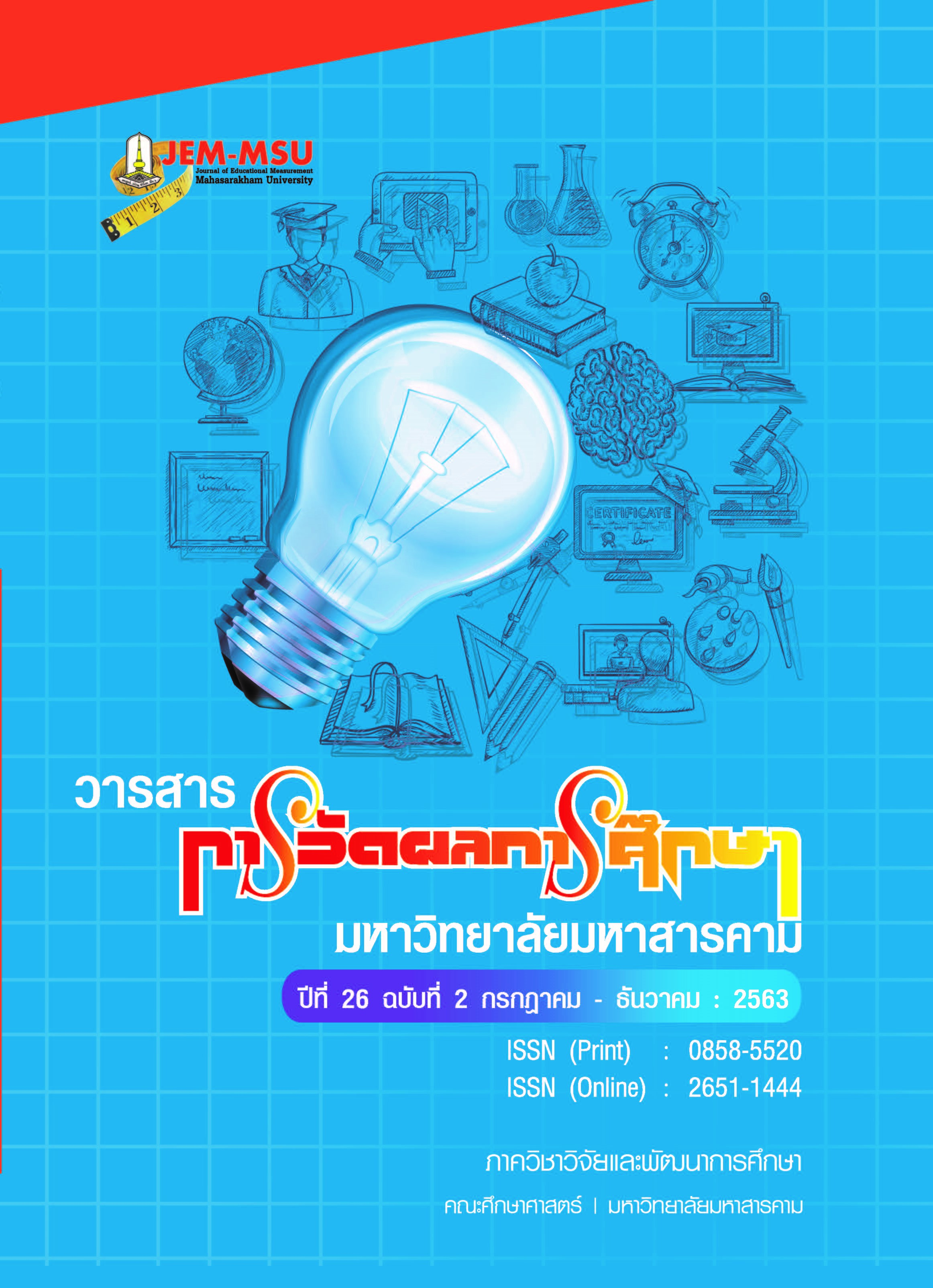A Study of Effects of Using the Diary Method to Assess Attitude towards the Lesson
Main Article Content
Abstract
This research aimed to study the use of diary to assess learners’ attitude towards the lesson, analyze reliability of inter-rater and to synthesize recommendations for using diary for learners’ attitude assessment. Data were collected from 168 diaries in an educational project. Each diary was assessed by 3 out of 12 raters. The raters and the diaries were randomly matched. Each rater assessed the text and recorded the frequency of learner’s messages about the attitude towards the lesson that was related to assessment criteria. Then a content analysis was carried out and an analysis of reliability of inter-rater followed, using interclass correlation coefficient (ICC) and Krippendorff’s alpha coefficient: (KAlpha) to confirm the reliability of inter-rater.
The results revealed that the data from the diaries had a required quality and the frequencies recorded were different. The majority of the raters obtained different frequencies of the messages consistent with the assessment criteria. This resulted in the reliability being in the low to moderate levels, with the ICC between -.004 - .515, which was consistent with the KAIpha which was between -.003 and - .495. On the whole, in using the diary method, the rater must be aware of bias from interpretation and different learning styles among learners.
Article Details
The content and information contained in the published article in the Journal of Educational Measurement Mahasarakham University represent the opinions and responsibilities of the authors directly. The editorial board of the journal is not necessarily in agreement with or responsible for any of the content.
The articles, data, content, images, etc. that have been published in the Journal of Educational Measurement Mahasarakham University are copyrighted by the journal. If any individual or organization wishes to reproduce or perform any actions involving the entirety or any part of the content, they must obtain written permission from the Journal of Educational Measurement Mahasarakham University.
References
ปราณี ทองคำ. (2548). สภาพการใช้และความพึงพอใจของนักศึกษาที่มีต่อการเรียนการสอนใน ห้องเรียนเสมือน: กรณีศึกษารายวิชา 266-416 การวิจัยสำหรับครู. http://educms.pn.psu.as.th/ojs-room/ viewarticle.pht?id=4
มลิวัลย์ ภักดิ์ประไพ. (ม.ป.ป). การเขียนไดอารีและไดอารีออนไลน์: ความคิดเห็นของผู้เรียนวิชา การเขียน ย่อหน้า (205222 Paragraph Writing). คณะมนุษยศาสตร์ มหาวิทยาลัยนเรศวร. http://www.human.nu.ac.th/ jhnu/ file/ journal/2014.pdf
Bartlett, R., & Milligan, C. (2015). What is diary method?. Bloomsbury Publishing.
Bartko, J. J. (1966). The intraclass correlation coefficient as a measure of reliability. Psychological reports, 19(1), 3-11.
Bolger, N., Davis, A., & Rafaeli, E. (2003). Diary methods: Capturing life as it is lived. Annual review of psychology, 54(1), 579-616.
Broom, A. F., Kirby, E. R., Adams, J., & Refshauge, K. M. (2015). On illegitimacy, suffering and recognition: A diary study of women living with chronic pain. Sociology, 49(4), 712-731.
Broom, A., Meurk, C., Adams, J., & Sibbritt, D. (2014). Networks of knowledge or just old wives’ tales?: A diary-based analysis of women’s self-care practices and everyday lay expertise. Health:, 18(4), 335-351.
Csikszentmihalyi, M., & Larson, R. (1984). Being adolescent. Basic Books.
Csikszentmihalyi, M., Larson, R., & Prescott, S. (1977). The ecology of adolescent activity and experience. Journal of youth and adolescence, 6(3), 281-294.
Eckenrode, J., & Bolger, N. (1995). Daily and within-day event measurement. In S. Cohen, R. C. Kessler, & L. U. Gordon (Eds.), Measuring stress: A guide for health and social scientists (pp. 80 –101). New York: Oxford University Press.
Flaherty, K.(2016). Diary studies: Understanding long-term user behavior and experiences. Nielsen Norman Group Articles, June, 5, 2016.
Fleming, N.D; (1995), I'm different; not dumb. Modes of presentation (VARK) in the tertiary
Gleason, M. E., Iida, M., Bolger, N., & Shrout, P. E. (2003). Daily supportive equity in close relationships. Personality and Social Psychology Bulletin, 29(8), 1036-1045.
Hopkins, G. (1999). Journal Writing Every Day: Teachers Say It Really Works. Retrieved from http://eduation-world.com/ a_curr/curr144.shtml
Krippendorff, K. (2011). Computing Krippendorff's alpha-reliability. Retrieved from https://repository.upenn.edu/asc_papers/43/
Lallemand, C.(2012). User experience. Retrieved from http://uxpamagazine.org/dear-diary-using-diaries-to-study-user-experience/
Laurenceau, J. P., & Bolger, N. (2005). Using diary methods to study marital and family processes. Journal of Family Psychology, 19(1), 86.
Lockhart, D., & Schmeck, R. R. (1983). Learning Styles and Classroom Evaluation Methods: Different Strokes for Different Folks. College student journal, 17(1), 94-100.
Ma, R., & Oxford, R. L. (2014). A diary study focusing on listening and speaking: The evolving interaction of learning styles and learning strategies in a motivated, advanced ESL learner. System, 43, 101-113.
Parke, R. D. (2004). Development in the family. Annu. Rev. Psychol., 55, 365-399.
Perrez, M., Schoebi, D., & Wilhelm, P. (2000). How to assess social regulation of stress and emotions in daily family life? A computer‐assisted family self‐monitoring system (FASEM‐C). Clinical Psychology & Psychotherapy: An International Journal of Theory & Practice, 7(4), 326-339.
Shiffman, S., Hufford, M., & Paty, J. (2001). Subject experience diaries in clinical research: Part 1. The patient experience movement. Applied Clinical Trials, 10, 46-56.
Stone, A. A., Shiffman, S., Schwartz, J. E., Broderick, J. E., & Hufford, M. R. (2002). Patient non-compliance with paper diaries. Bmj, 324(7347), 1193-1194.


